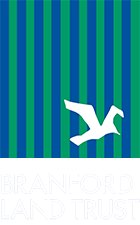Branford has a good diversity of natural habitat: upland woods and fields, fresh water wetlands, and salt marshes. All of these types of habitat can be found on one or another Land Trust property. Each natural area has its own appeal and identity, and a person with an interest in the natural world can always discover something of interest.
The makeup of its biological communities is determined by Branford’s location. Salt marshes line the Branford River, the Farm River, and several tidal creeks that drain into Long Island Sound. The vegetation here is dramatically different from elsewhere, with distinctive plants such as cord grass, spike grass and the common reed Phragmites. These areas are the nurseries for fish and shellfish that populate the Sound, and they provide feeding sites for shore birds and nesting sites for osprey and egrets. Along the shore, there are also small stands of pitch pine, sometimes mixed with post and scrub oak. These unusual and distinctive communities occur in areas with poor soil, sometimes on rocky ‘islands’ surrounded by salt marsh.
Another feature that sets Branford apart from many Connecticut towns is the presence of a few trap rock ridges, part of the southern end of the Metacomet Ridge system that runs north along Connecticut’s central valley from Long Island Sound into Massachusetts. The trap rock ridges tend to support spring wildflowers such as bloodroot or Dutchman’s breeches in greater concentrations than other locations.
Inland, the undeveloped upland is largely forested. Branford, like much of New England, was extensively farmed for much of the last 350 years, so the woodlands that we now have are all what is loosely termed “second-growth” – i.e., they have grown back after the land was cleared, whether for agriculture or lumbering.
Until the late 1980s, Branford’s woodlands contained some large areas of mixed hemlock and hardwood (mainly oaks, hickories and beech), but the hemlock woolly adelgid, an aphid-like insect, has killed most of the hemlock, so the woods are now becoming predominantly hardwood. With the death of the hemlocks, the character of the forest has changed, acquiring a more open feeling and experiencing a resurgence of young trees, ferns, and wildflowers as more sunlight reaches the forest floor. Elsewhere, some stands of trees, in the Supply Ponds for instance, are dominated by sugar maple. Many other kinds of trees also grow in Branford, including tulip, chestnut oak, American elm, white pine, red cedar, sassafras, red maple, and tupelo. Unfortunately, along with the hemlock, we have in recent years lost our ash trees (emerald ash borer) and now the beech trees are facing a grave threat from Beech Leaf Disease.
There are fields and meadows (several on Branford Land Trust properties) that are the remnants of Branford’s agricultural past, today maintained as such by mowing or slowly reverting to forest. These open grasslands, particularly those with diverse wildflowers, host birds such as bluebirds and American kestrels as well as butterflies and other interesting insects.
Branford’s freshwater wetlands and watercourses provide yet other types of habitat. Most are wooded swamps, dominated by red maple and other trees that tolerate having their roots wet, with smaller trees and shrubs such as spicebush, sweet pepperbush, and winterberry. Other types of wetland include wet meadows, vernal pools, and ponds, each containing a distinctive array of plants and animals. Some of these (Towner Swamp/Hoadley Creek, the Pisgah Brook/ Supply Ponds watershed) are extensive and complex systems with a variety of different wetland types.
The animal life is typical of much of Connecticut, with an abundance of deer, raccoons, opossums, skunks, squirrels, foxes and recently, eastern coyotes, bobcats, and fishers (a large weasel), and occasionally a wandering black bear. Branford has yet to see a moose, a species that has been sighted in the more rural parts of the state. As for birds, the late Noble Proctor, world-famous ornithologist and Branford resident, counted 301 species in Branford (out of about 404 species that are known to occur in Connecticut) over 30 years of bird watching.
We invite you to become acquainted with Branford’s biological communities as you explore the Land Trust’s preserves.


